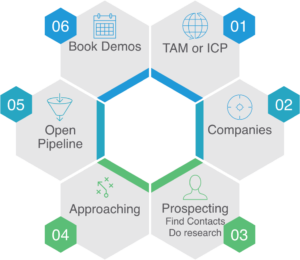Let’s take a minute to ensure the most important factors that affect the bottom line have a spotlight on them. Specifically, we’re focusing on the sales development process and how to build a sales pipeline — all from a high level.
We’re charging forward with 6 simple steps to ensure that the focus is not lost along the path to accurate sales forecasting and predictive revenue.
The Modern-Day Revenue Engine
In its simplest form, the modern day revenue engine relies on two things:
- Setting up qualified meetings (SDRs)
- Closing deals (AEs)
The 6 steps below outline the “30,000 feet up” view of the sales development funnel + the process built around it to make sure it’s working smoothly.
So take your fingers and pinch the screen if you’re reading this on mobile because we’re scrolling way out.
How to build a sales pipeline in 6 steps

Step 1. Identify your ideal customer profile and target market.
Step 2. Spot your target companies/target accounts.
Step 3. Find internal contacts and do research.
Step 4. Reach out to your internal contacts.
Step 5. Segment and work your pipeline.
Step 6. Move Your SQLs Further Down the Funnel/Book Demos
Step 1: Identify Your Ideal Customer Profile and Target Market
The impact of your ICP
Characteristics of your ideal target customers will render the total number of customers your business is able to sell to based on either a bottom-up or top-down approach. Most likely this number is fluid and will change over time.
Who’s responsible?
The CEO, founding team, and other C-level execs.
The cadence for updating
Minimum 1x/year (more often for companies younger than 3 years old)
Step 2: Spot Your Target Companies/Target Accounts
Use your ICP to get started
These are the potential companies your business is able to sell to based on either a bottom-up or top-down approach. Just like in step 1, it’s fluid and will change over time and is derived from the ICP.
Who’s responsible?
The CEO, CRO, or VP of Sales.
The cadence for updating
Minimum 1x/year (more often for companies younger than 3 years old)
Related: PODCAST 15: The Art and Science of Pipeline Generation
Step 3: Find Internal Contacts and Do Research
Work through your list of target accounts
Build a list of internal contacts to target based on your company’s buyer persona.
Using certain criteria defined by your buyer personas, build a list with “x” number of contacts/leads per company that you’re targeting. For example, you may go after a certain title for a small company and, say, 3+ different titles within a larger company on your “Target Account” list.
Note: it’s important to differentiate the steps included here:
- Find names of contacts within your target account (map personas, or titles against the company)
- Enrich those contacts with contact information; somewhat commoditized but obviously very important. This includes the email address and phone number.
- Research to find truly personal data and metadata points on both the person and the company.
Who’s responsible?
The CEO, CRO or VP of Sales build the criteria. The SDR/BDR sources them.*
*There are essentially two approaches here:

- Method #1: Buy a list programmatically to get these names, contact details, and personalization information
- Method #2: Manually search and add these names, contact details, and personalization information. The cost differs considerably based on quality and industry.
The cadence for updating
Minimum 1x/year (more often for companies younger than 3 years old)
Step 4: Reach out to Your Internal Contacts
Set up your sales cadence for outreach
Reach out to the contacts within the target companies, as defined in steps 2 and 3. Phone call, email, social touches or even direct mail among other methods are standard here.
Who creates these cadences?
SDRs/BDRs
When do you update this?
Daily. This should be an ongoing effort by your outbound sales reps. And a general rule of thumb—reach out to a company (at least 3 contacts at that company at once) every 90 days.
Step 5: Segment and Work Your Pipeline
Focus on value-based selling
Salespeople don’t talk to companies. They talk to humans—building authentic relationships. Again, talking with not at people. Be curious and ultimately, help drive value.
Ideally, each salesperson always has a pipeline of “replied”, “working”, “verbal—demo commits”, and “scheduled” contacts within their personal pipelines. Within each of those categories also comes scripts to overcome objections.
Who’s responsible?
SDRs/BDRs
The cadence for updating
Daily. It should be an ongoing effort by your outbound sales reps.
Step 6: Move Your SQLs Further down the Funnel/Book Demos
The SDR-AE handoff
This is the final step of the SDR/BDR journey that embodies the “completion” of their task. They pass off sales qualified leads to the closer (Account Executive) to further qualify, asses needs, and work through the sales pipeline until Closed-Won or Closed-Lost.
Who’s responsible?
SDRs/BDRs
The cadence for updating
Daily, ongoing. Re-evaluate this process to make sure it’s working smoothly on a quarterly basis. Meet with both the SDRs/BDRs and the AEs in the same room.







